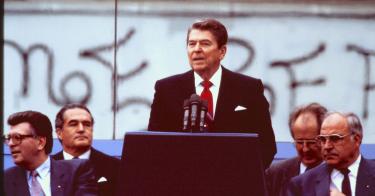June 12 marks the 35th anniversary of President Reagan’s Brandenburg Gate speech—memorable for the six words still stuck in our consciousness today, “Mr. Gorbachev, tear down this wall.” It didn’t get much publicity at the time, and the real effects of it, as of any speech, are always an open question. Only later would we get a sense of its real import. After 25 years of a bifurcated Berlin, the speech became a harbinger of what was to come.
I remember well the cool evening in Munich, Germany—the evening of August 12th, 1961. Some college friends and I were celebrating my 20th birthday in one of Munich’s legendary Bierhallen. For the next day we had made arrangements to drive the Autobahn up to Berlin, but at the very instant our spirits were going up, the gull-gray edifice of the Berlin Wall was too.
Berlin itself, the former capital of Nazi Germany, was situated in the center of East Germany, almost a hundred miles from democratic West Germany. The Berlin Wall divided the city into two: East Berlin under Soviet control, West Berlin under the administration of the United States, Great Britain, and France. West Berlin became a small island of freedom within a hostile totalitarian state.
The wall itself dashed the dreams of millions hoping to defect to the West. More than a hundred thousand would try—with hundreds shot down in the attempt.
>>> 30 Years in Making, Museum Dedicated to Victims of Communism Opens in Washington
It’s difficult for generations who came of age after it to understand what it was like to live during the Cold War (1947–1991). These kinds of stories were common on the nightly news, and the threat of nuclear war haunted at all times.
But despite the specter of sudden annihilation, the United States enjoyed tremendous growth in the years after the Second World War. The Western ideologies of democracy and free markets went head-to-head against Marxism-Leninism. And the outcomes couldn’t have been more different.
In East Berlin, severe economic malaise, a predictable consequence of communist governance, made quality-of-life differences very apparent between the two halves of the city. Paranoia, fear, poverty, neglect, and ruin typified life in East Berlin, while West Berlin was a glittery jewel in comparison.
The Wall itself became a very real symbol of oppression. Over a quarter of a century later, Reagan famously implored the last Soviet leader, Mikhail Gorbachev, to “tear down this wall.”
In the speech he also remarked how well West Berlin had recovered from the war. Noting the sector’s key features, Reagan found “the greatest industrial output of any city in Germany: busy office blocks, fine homes and apartments, proud avenues, and the spreading lawns of parkland.” Wrapping up, he concluded,
As I looked out a moment ago from the Reichstag, that embodiment of German unity, I noticed words crudely spraypainted upon the wall, perhaps by a young Berliner:
“This wall will fall. Beliefs become reality.”
Yes, across Europe, this wall will fall, for it cannot withstand faith; it cannot withstand truth. The wall cannot withstand freedom.
The failure of every aspect of the Soviet system grew far beyond the USSR’s ability to handle, and everyone knew it. Including Gorbachev.
The Wall itself was indeed torn down two years later, in November of 1989, this dramatic change being as momentous as the time the Wall went up. A full reversal, it ushered in a new beginning for those living under the tyrannical Soviet regime, an opportunity to break their chains and to start, and restart, their lives under the values that made the U.S. and her Western allies so prosperous: democracy, rule of law, and the fostering of civil and economic rights. The final chapter for the Soviet-style Marxism-Leninism ended just two years later, as the USSR formally dissolved on the day after Christmas in 1991, a gift to the world.
>>> Putin the Marxist-Leninist
In the 30 years since, Russia’s lot has improved somewhat in terms of interior governance, but the 2022 Heritage Index of Economic Freedom ranks it almost last in Europe, and 113th overall. It’s not the power it once was nor the power it wants to be. Its spectacularly illegal and inept invasion of Ukraine would be just an embarrassment if the human cost were not so staggering. War crimes and civilian massacres often accompany despotic regimes, in which freedom itself is a crime.
Worldwide, communism in action today remains a shell of its former self, and that it gets any credence as a viable governing philosophy is astounding given its very visible public record. It brings only pockets of prosperity to its oligarchs and to those whom it allows some degree of private property and other rights.
Perhaps President Reagan’s greatest gift to America was to accelerate the demise of the Soviet Union by rebuilding our military, ratcheting up the economic pressure on our adversaries, and expounding his “peace through strength” posture. But, in my opinion, the Brandenburg Gate speech highlighted to the world that standing up to communism with strength and straight talk can pave the way for freedom and prosperity. Let’s not forget that lesson today.
This piece originally appeared in The National Review




